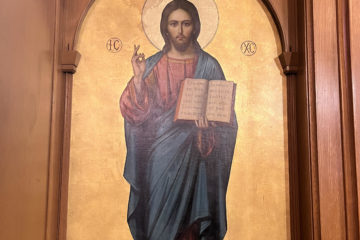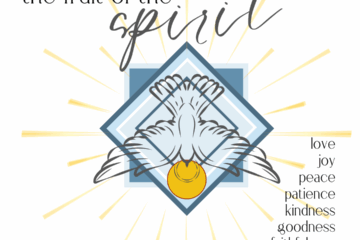On the evening of that day, the first day of the week, the doors being shut where the disciples were, for fear of the Jews, Jesus came and stood among them and said to them, “Peace be with you.” When He had said this, He showed them His hands and His side. Then the disciples were glad when they saw the Lord. Jesus said to them again, “Peace be with you. As the Father has sent Me, even so I send you.” And when He had said this, He breathed on them, and said to them, “Receive the Holy Spirit. If you forgive the sins of any, they are forgiven; if you retain the sins of any, they are retained.” Now Thomas, one of the twelve, called the Twin, was not with them when Jesus came. So the other disciples told him, “We have seen the Lord.” But he said to them, “Unless I see in His hands the print of the nails, and place my finger in the mark of the nails, and place my hand in His side, I will not believe.” Eight days later, His disciples were again in the house, and Thomas was with them. The doors were shut, but Jesus came and stood among them, and said, “Peace be with you.” Then he said to Thomas, “Put your finger here, and see My hands; and put out your hand, and place it in My side; do not be faithless, but believing.” Thomas answered Him, “My Lord and my God!” Jesus said to him, “Have you believed because you have seen Me? Blessed are those who have not seen and yet believe.” Now Jesus did many other signs in the presence of the disciples, which are not written in this book; but these are written that you may believe that Jesus is the Christ, the Son of God, and that believing you may have life in His name.
John 20: 19-31 (Gospel from Thomas Sunday)
Christ is Risen!
There is a LOT of things to take away from the Gospel lesson of today. First, we read the historic narrative of Jesus’ first and second encounters with the Disciples after the Resurrection. He appeared through a closed door on the evening of the day of His Resurrection. Ten of the Disciples were present. Judas obviously had hanged himself, and Thomas was not present. Eight days later (which in the Jewish way of counting is 7 of our days, so the Sunday after the Resurrection, today, is the day this would have happened), Jesus again appeared to the Disciples and Thomas was with them this time.
Thomas is one of the most real and refreshing figures in the New Testament. If there was a Biblical figure I related most to, it would probably be him. Thomas had followed Jesus for three years. Most certainly he would have considered Jesus a friend, a trusted companion, and Jesus would have considered Thomas the same. He saw everything that Jesus had foretold happen. The betrayal, the trial, the Crucifixion, and certainly He would have known of the empty tomb. When the Disciples saw the risen Lord and were so glad, they told Thomas the good news. But he wouldn’t believe the testimony of ten trusted friends, he wanted to see proof himself. When Jesus came to the Disciples a second time, Thomas was present. Jesus showed Thomas His hands and His side. Then Thomas made what is considered the “greatest confession” of Jesus as the Christ in the New Testament, when he said to Him, “My Lord and my God.” (John 20: 28) Jesus said to Thomas “Have you believed because you have seen Me? Blessed are those who have not seen and yet believe.” (20:29) And here is the essence of what it means to have faith. We haven’t had the benefit of seeing Jesus the way the Disciples did. We haven’t shook His hand, or had a meal with Him. Yet, many people of today, and millions of yesteryear have dedicated their lives to Him, some even dying as martyrs for Him. Faith is believing without seeing. However, our faith is not a blind faith, in the sense that we know nothing about Jesus. We know plenty about Him. And we have seen through the example of so many, what a life in Him looks like. Then it comes down to a choice—to believe based on what we have seen and heart, or to not believe. Thomas is a refreshing figure in the Bible because he reminds us that even the closest Disciple will have his moments of doubt. Thomas, however, did not leave the group of the Disciples. He stayed and then had his life-changing encounter with Jesus. If you’ve never had a life-changing encounter with Jesus, remain like Thomas, with the church, and eventually if will happen.
Two sacraments of the Orthodox Church have their roots in this passage of Scripture. In verses 21-22, Jesus says to the Disciples, “’As the Father has sent Me, even so I sent you.’ And when He had said this, He breathed on them, and said to them, ‘Receive the Holy Spirit.’” This is the first “ordination” if you will. Jesus commissions the Disciples, sending them out in the same way that the Father sent Him out. He breathed the Grace of the Holy Spirit on them. Later on, in the book of Acts, the laying on of hands would be added.
Continuing in verse 23, after bestowing on them the grace of the Holy Spirit, Jesus said to them “If you forgive the sins of any, they are forgiven; if you retain the sins of any, they are retained.” This is the foundation of the Sacrament of Confession. It is not the confessing of sins that makes this a sacrament. Anyone can confess sins to anyone else. The sacrament is the prayer of Absolution offered by the priest or bishop that wipes away the sins and fully reconciles the penitent back to God. Christ gave this gift and responsibility of loosening or retaining sins to the Apostles, who in turn gave it to bishops, who in turn bestow it to priests to this very day. The Bishop prays over a priest to have discernment in hearing the confessions of the faithful. When a confessor (priest or bishop hearing a confession) discerns the repentant heart of the penitent (the one going to confession), he offers the prayer of Absolution and the sin is removed from that person’s life record. They no longer need to carry the burden of guilt over it. On rare occasions, the confessor will “retain” a sin, requiring the penitent to do an act of penance and then loose the sin. This is not done regularly, but in circumstances when either the confessor discerns that the penitent is not repentance, or more likely, in circumstances when the penitent has continued anxiety over what they’ve confessed. The prayer of Absolution tells the penitent to have no further anxiety over the sins they have confessed. If that is not a true statement, then the confessor may suggest a penance.
The final thought on today’s Gospel passage is the closing verses of Chapter 20. Though there is one more chapter of the Gospel of John following Chapter 20, John makes a preliminary close to his Gospel by telling the reader that there were many other signs, not just the greeting of Thomas, that were done by Jesus after the Resurrection. However, the Evangelist has chosen to share a sampling of them, enough so that the reader “may believe that Jesus is the Christ, the Son of God, and that believing you may have life in His name.” (John 20:31)
After eight days from Your resurrection, O Jesus our King, and the Father’s only-begotten Word, You appeared to Your Disciples, the doors being shut; and You granted them Your peace. And to the disbelieving Disciple You showed the marks on Your body. “Come and touch my hands and my feet, and my uncorrupt side.” And he believed and cried to You, “My Lord and my God, glory to You.” (Doxastikon, Feast of Thomas Sunday, Trans. by Fr. Seraphim Dedes)
Our entire lives, we will battle with doubt and faith. Thomas won the battle by showing up eight days after the Resurrection. After a week of doubt he was still present. Keep showing up for Christ. It can only serve to strengthen your faith, especially in times of doubt.


0 Comments